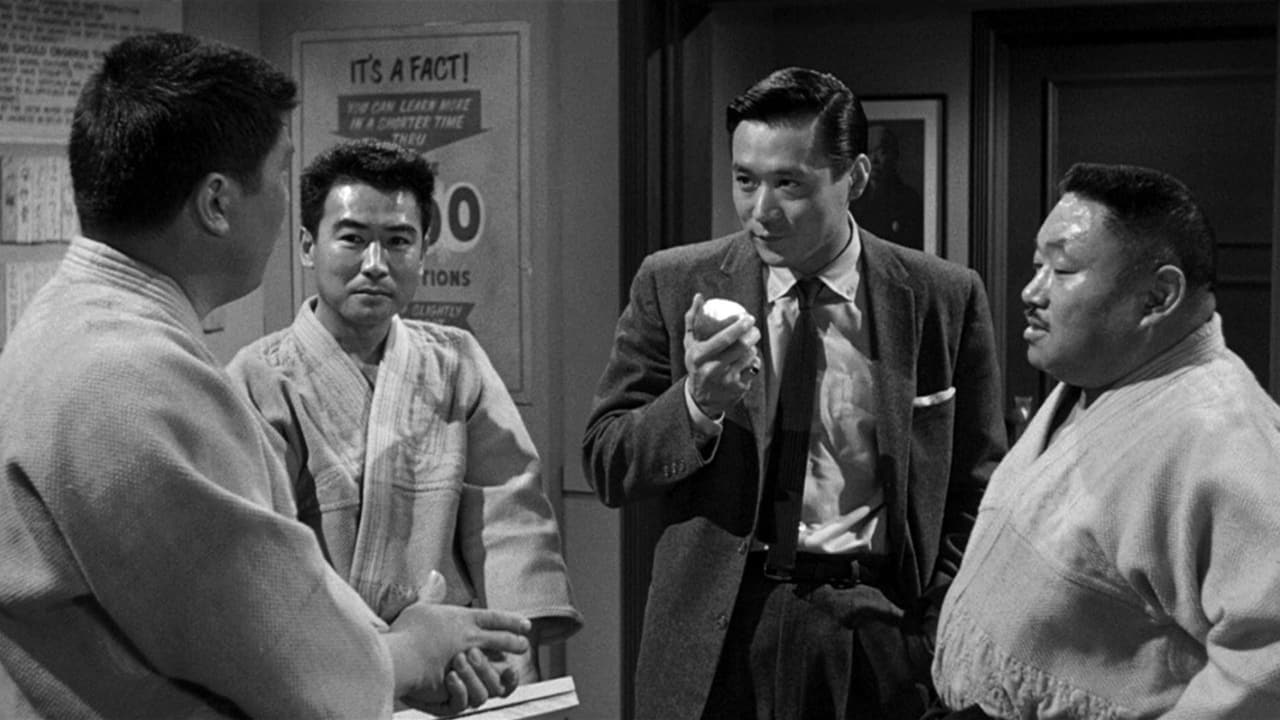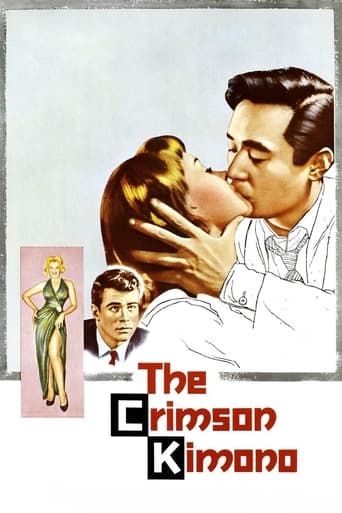

Against Hollywood's mainstream value, Samuel Fuller's vintage L.A. murder mystery gallantly sets off a love triangle where a Caucasian woman falls for an Asian man in lieu of the latter's Caucasian friend, but the nisei has his own battle to fight, concerning the congenital racial bias stigmatized Japanese-American in the wake of WWII. Yes, first of all, there is a murder, a burlesque stripper Sugar Torch (Pall) is gunned down on the main street in the Little Tokyo district, and two detectives Joe Kojaku (Shigeta) and Charlie Bancroft (Corbett) are investigating the case, they are Korean war veterans and best friends, even sharing a snug apartment, their police procedural pans out a bit languorously, but Fuller profiles the enclave's ethnographic traits with a wandering eye, while the meat of the story is concerned with a key witness, Christine "Chris" Downes (Shaw), who paints the portrait of Sugar Torch dressed in a crimson kimono for the preparation of a Japanese-themed act (one can only imagine what technicolor would do justice to the chromatic appeal here). When her own life is in peril after drawing an identikit of the possible killer, Joe and Charlie invite Chris to stay in their apartment, naturally both bachelors become besotted with her, but it is the interracial romance gains an upper hand (Joe is the more refined, sensitive and art-savvy one), which leaves Joe clammed up in a state of guilt of betraying his best friend, as he knows Charlie reckons Chris as the girl of his dreams, and when the truth finally comes out, Joe's inborn inferiority complex reaches a boiling point, moreover, let's not forget a heartless killer is still at large (although a whodunit's allure has seismically eclipsed by a torrid love triangle at that stage), and Fuller fabricates an analogous tie-in between the killer and Joe, which rounds off the story adequately during the annal Japanese pageant in the Little Tokyo.A fly in the ointment is that Fuller insensitively shoves the moral ambiguity to Chris, being the one who is courted by both men, she doesn't refuse Charlie's advance in the first place and acquits herself as if she has no qualm of reciprocating Joe's feelings, then, even egregiously acts oblivious of the fact that it is her deeds drive a wedge between them, and isn't it up to her to clear the air? Of course, such action isn't allowed in Fuller's script. Consequently, audience will find more relish in a Bourbon-tippled Anna Lee, whose worldly counsel including "Love does much, but Bourbon does everything!". A Golden Globe-winning Shigeta seizes upon this rare opportunity vested by this groundbreaking treatment of racial minority and the lingering, deleterious fallout of WWII afflicting on the next generation, thus, breaks the glass ceiling as an Asian leading actor, with his palpitating affection and disarming demeanor, in Fuller's off-the-radar metteur en scène.
... View MoreOn one hand, you wouldn't know that this is a detective story without reading the synopsis, unless you had closed captions, which they didn't have in 1959.On the other hand, you would know the story by images.Fuller pretty much is the story here, as the director. This is stamped completely with his presence, be it good or bad.I grasped the story, so it was good, but should have been better.Meaning that there is audio and there is video. Fuller fully flunked "audio", but aced "video" with extra credits.I made the mistake of not using closed captions in watching this. Bad idea. I'm not referring to the times when people speak Japanese. I refer to the times when English is allegedly spoken, by American actors. What a disgrace. You can't understand half of what the actors say, and not a single actress could enunciate. They were as bad as modern day actresses. Strangely, the actors who spoke clearest had the fewest lines.Still, Fuller had a mastery of "video". He managed to show the story, in a logical progression, with body language and with excellent staging.What the performers lacked in enunciation skills, they made up for in acting ability, with expressions, save for the deadpan Corbett. His lack of ability to show expressions is much like Clint Eastwood. However, of the leads, he was the only one who could speak clearly.This made what seemed like a bag of mixed nuts. Did Fuller do this on purpose? Thee wasn't closed captioning in the movie theaters. This had to be an issue.Then there is the story. A stripper is murdered. However, we don't know what the Sam Hill is going on, and we have to sit through some mushy outdated style love triangle, wondering if the two detectives ever go to work, or if they are paid to romance a girl, like she's the only girl in L.A.It's handled pretty well, and like I said, Fuller is a crafty director with visuals. Like most good directors, he fools us into thinking there is more action than there really is, by used of animation and good blocking. Textbook video directing.So even an attention deficit type like myself doesn't get overly bored with the mush that lasts forever. In fact, Fuller's directing enables us to sit through the "chick flick" portion.While the detectives seem to forget they have a case, we never forget, however. We keep wondering what is going on.The romance between Caucasian and Japanese would be outdated within ten years, of course, but the fact that Shigeta barely resembles an Oriental kind of makes it mute. He looks like he's about 1/32 Oriental to begin with. However, his acting ability helps to pass himself off for the role.Overall, a decent flick. Watch it with closed captions, though.
... View MoreAfter a stripper is shot dead, two LAPD officers investigate. Corbett and Shigeta, each making his film debut, play the cops. Corbett does OK, but Shigeta appears to be an unnatural actor; he looks like he is simply reading his lines. The murder investigation becomes secondary as the film focuses on the love triangle between the two cops and an artist, played by beautiful Australian actress Shaw. Fuller had a tendency to tackle social issues in his films and here it is the interracial romance between Japanese Shigeta and Shaw. Unfortunately, the romance is rather clumsily handled and the film goes off in too many different directions before abruptly wrapping things up too neatly.
... View MoreMaybe it's just me, but only a short time into this film I was already wondering just WHO acts like these characters?! For instance, there is a stripper (sugar Torch) who was planning a classy(?) striptease act where she would dress as a Japanese woman in a crimson kimono and two men would fight over her--one with a kitana (Japanese sword) and the other using his bare hands and karate. Another woman is a bohemian painter who talks in a very broad style and throws beer on canvases and seems a bit like Maynard G. Krebs. So, at the onset I was taken out of the moment because the film was trying too hard to be different. While director Sam Fuller's films usually excel at realism, this one just didn't quite make it. It's a shame, as I've loved many of his films and from this point on, it would be hard to sell me on THE CRIMSON KIMONO.The film begins with some maniac chasing Sugar Torch out of the theater after she finishes her act. She is gunned down in the middle of the street AND the killer takes the time to shoot a painting of her in the kimono in the throat that is in the dressing room. Two police detectives, Glenn Corbett and James Shigeta are sent in to investigate this murder in the Japanese section of Los Angeles. Naturally, with the bullet in the painting they think that there is something more to it. It's even MORE so when someone tries to shoot the artist ("Chris") next--though HOW the killer could have missed when he shot at her is beyond me.Now I noticed that some call this movie an example of Film Noir. However, I really didn't see that. Part of this was because the music was heavy on violins and sounded more akin to the soundtrack from PEYTON PLACE, the camera angles and darkness of typical Noir is missing and the characters are just too pretty--particularly the men, Shigeta and Corbett. When I think Noir, I think snappier and grittier dialog and ugly guys like John Ireland, Edmond O'Brien or Broderick Crawford. Plus, there is an interracial love interest that I liked...but it just didn't seem like Noir. Noir is NOT just a cop film but a style and attitude this one lacked--not that it was badly directed or produced. At heart, it's much more of a romance film.As for the interracial love interest, BOTH cops fall for Chris (the woman painter; had it been some other Chris, this might have been REAAAALLLY interesting and daring). And, Chris is feeling very strong feelings towards Shigeta. Eventually, the two men come to blows over this woman during a kendo match. Shigeta is convinced that his partner is a racist, though he seems to be reading something into his partner's (and long-time friend) thoughts and actions. However, Corbett is feeling normal jealousy...and still cares about his friend deeply. And, it turns out that the motivation for the killing early in the film is related, in a way, with Shigeta's struggle.Overall, despite a very rough beginning and it being incorrectly labeled 'Noir', the movie turned out to be pretty good and daring for its interracial love story. Yes, it had been done before in movies such as SAYONARA, but it was still a tough sell in 1959. Well worth seeing.
... View More